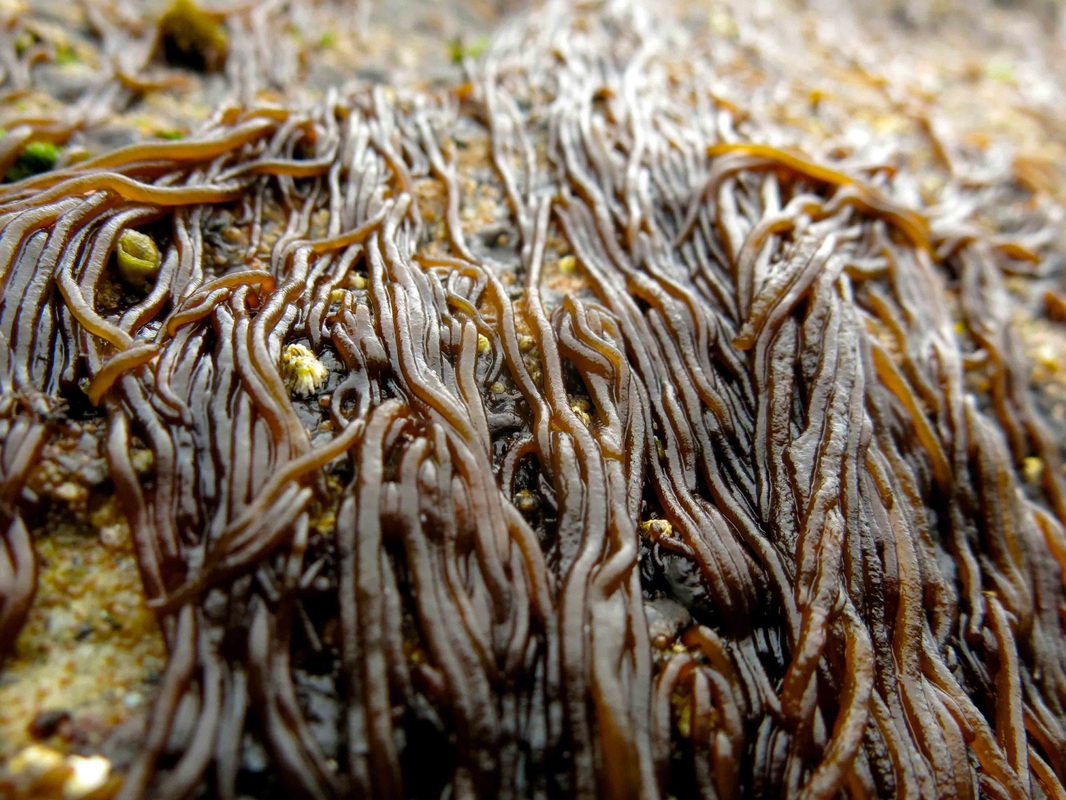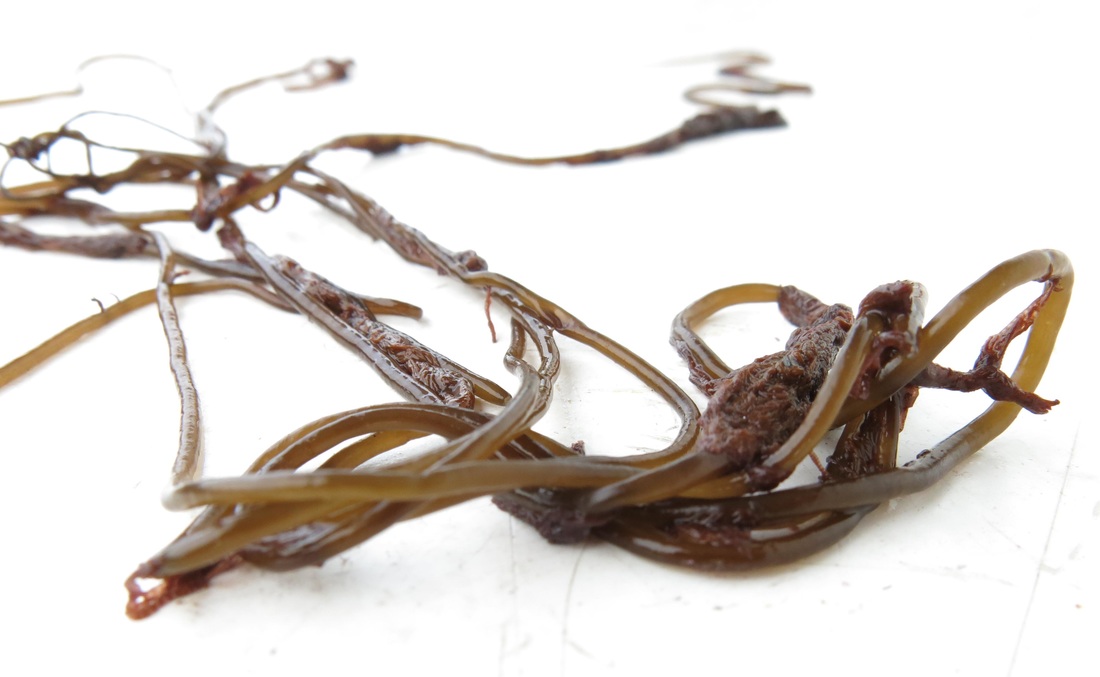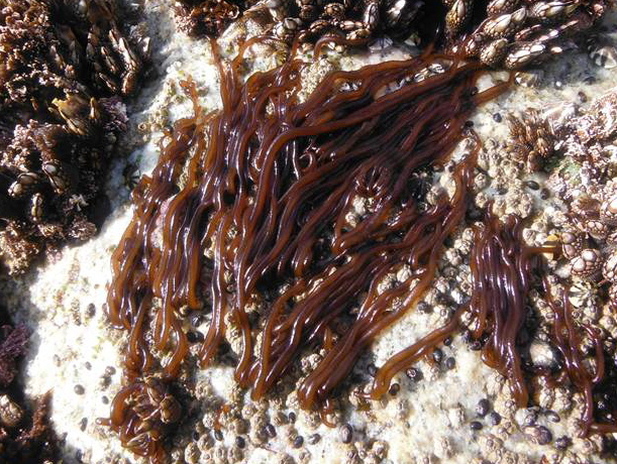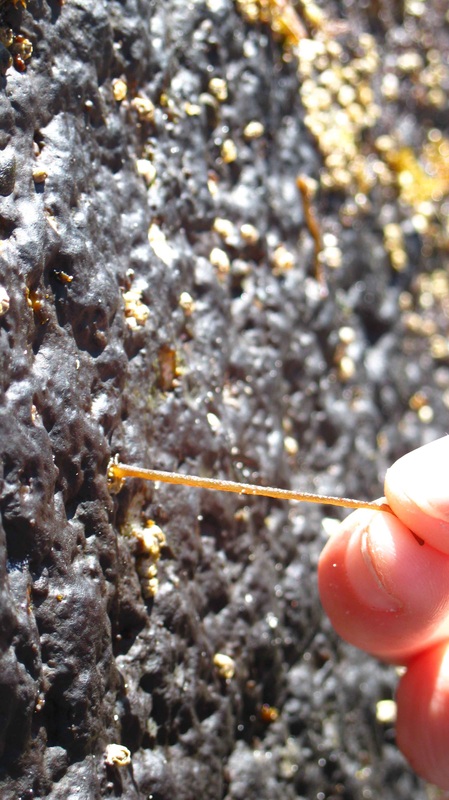Rubber threads • Nemalion elminthoides, N. helminthoides
Identification
The gametophyte of this red seaweed resembles long smooth worms or cooked spaghetti. It is usually reddish-brown in colour, though it may vary to deep purple or golden brown. It is solid and rubbery; branching is rare, and doesn't occur near the tips. It tends to grow in clumps, attached to rocks by a small cushion-like holdfast. While it can grow to 45 cm long, it is usually no more than 20 cm. The sporophyte for this species is microscopic.
Habitat & Range
This seaweed can be found during the summer months on exposed rocky shores, usually growing on or around mussels, barnacles, and limpets. Its eastern Pacific range extends from northern Alaska to northern Mexico; it is also found along coastal Japan, Australia, New Zealand, and the North Atlantic.
Similar Species
This species may be mistaken for a marine worm if not examined closely enough.
The gametophyte of this red seaweed resembles long smooth worms or cooked spaghetti. It is usually reddish-brown in colour, though it may vary to deep purple or golden brown. It is solid and rubbery; branching is rare, and doesn't occur near the tips. It tends to grow in clumps, attached to rocks by a small cushion-like holdfast. While it can grow to 45 cm long, it is usually no more than 20 cm. The sporophyte for this species is microscopic.
Habitat & Range
This seaweed can be found during the summer months on exposed rocky shores, usually growing on or around mussels, barnacles, and limpets. Its eastern Pacific range extends from northern Alaska to northern Mexico; it is also found along coastal Japan, Australia, New Zealand, and the North Atlantic.
Similar Species
This species may be mistaken for a marine worm if not examined closely enough.
References
Guiry, M.D. & Guiry, G.M. 2014. Nemalion elminthoides (Velley) Batters. National University of Ireland, Galway. Accessed 27/11/2014.
Lamb, A., and Hanby, B. (2005). Marine Life of the Pacific Northwest [electronic version]. Madeira Park, BC: Harbour Publishing.
Lindberg, M. and Lindstrom, S. (2010). Nemalion elminthoides. Seaweeds of Alaska. Accessed 27/11/2014.
O'Clair, R. and Lindstrom, S. Nemalion helminthoides (Velley) Batters. In Klinkenberg, Brian. (Ed.). E-Flora BC: Electronic Atlas of the Plants of British Columbia. Lab for Advanced Spatial Analysis, Department of Geography, University of British Columbia, Vancouver. Accessed 27/11/2014.
Authors and editors of page
Kelly Fretwell, Bridget Woods, and Brian Starzomski (2014).
Guiry, M.D. & Guiry, G.M. 2014. Nemalion elminthoides (Velley) Batters. National University of Ireland, Galway. Accessed 27/11/2014.
Lamb, A., and Hanby, B. (2005). Marine Life of the Pacific Northwest [electronic version]. Madeira Park, BC: Harbour Publishing.
Lindberg, M. and Lindstrom, S. (2010). Nemalion elminthoides. Seaweeds of Alaska. Accessed 27/11/2014.
O'Clair, R. and Lindstrom, S. Nemalion helminthoides (Velley) Batters. In Klinkenberg, Brian. (Ed.). E-Flora BC: Electronic Atlas of the Plants of British Columbia. Lab for Advanced Spatial Analysis, Department of Geography, University of British Columbia, Vancouver. Accessed 27/11/2014.
Authors and editors of page
Kelly Fretwell, Bridget Woods, and Brian Starzomski (2014).







